
GENERAL INTRODUCTION TO KANBAN AND EKANBAN
WHAT IS KANBAN?
Kanban, a Japanese term translating to “visual signal” or “card”, originally emerged as an ingenious scheduling system designed for lean manufacturing and impeccable inventory management. It emerged as a pivotal element of Toyota’s renowned Toyota Production System (TPS) in the 1950s. Kanban’s core mission was to lay the foundation for a production system driven by demand, leading to reduced waste, amplified efficiency, and heightened overall productivity.

The conventional Kanban system relied on tangible cards, often affixed to containers or bins, to signal the necessity for replenishing materials or products. These cards served as the catalysts for production or resupply actions, ensuring that inventory levels remained at their optimal points, steering clear of overproduction or shortages.
WHAT IS ELECTRONIC KANBAN (EKANBAN) ?
An electronic Kanban system represents a decentralized control mechanism rooted in the ‘fetch’ principle, harnessing electronic systems. These systems, owing to their diverse range and intricacies, offer valuable support for traditional manual Kanban processes, allowing swift responses to issues and bottlenecks.
Within warehouses employing an electronic Kanban system, material flow management relies on either Kanban containers or electronic Kanban cards. These cards function as a traditional means of identifying goods, with the added advantage that only the electronic information on the card (eKanban) needs to be transmitted to initiate a subsequent delivery. A commonly adopted approach is a two-container Kanban control system, where one container remains in production while the second is in transit for replenishment, ensuring a continuous flow of materials.

KEY COMPONENTS OF EKANBAN
- Digital Signals
Instead of relying on physical cards, eKanban uses digital signals to relay information regarding material consumption, replenishment requirements, and production statuses. These digital cues are typically transmitted through software systems or electronic devices. - Software Platforms
eKanban systems are supported by specialized software platforms, fostering communication, data tracking, and informed decision-making. These platforms can be seamlessly integrated with other manufacturing and supply chain management tools. - RFID Technology
Radio Frequency Identification (RFID) tags are commonplace in eKanban systems, diligently tracking the movement of materials and products. These RFID tags carry electronic data that can be read and updated via radio waves, enabling automated data capture.
HOW EKANBAN REVOLUTIONIZES MANUFACTURING
Digital Inventory Management
Every component is intricately associated with a unique digital identifier, such as an RFID tag or barcode. Whenever a component is consumed during production, the eKanban system seamlessly updates the inventory status for that particular item.
Automated Replenishment
As inventory levels get closer to a predefined threshold (reorder point), the eKanban system springs into action, generating automated signals for replenishment. These signals are promptly dispatched to suppliers or the central warehouse, setting the wheels in motion for the shipment of additional materials.
Real-time Monitoring
The eKanban system grants real-time visibility into inventory levels, production progress, and material movements. Stakeholders are empowered to access dynamic dashboards and comprehensive reports that offer a holistic view of ongoing operations.
Supply Chain Coordination
eKanban promotes seamless communication and collaboration across the supply chain spectrum. Suppliers are kept in the loop, receiving timely signals for replenishment, thus ensuring their fast response to the ever-evolving production needs.
Demand Fluctuation Response
Equipped with real-time data, eKanban enables manufacturers to quickly recalibrate production in response to shifts in demand. In the event of demand spikes, the system autonomously adjusts production and material orders with precision.
EKANBAN: THE FUTURE OF MANUFACTURING EFFICIENCY
In this blog, we’ve explored Kanban and eKanban, uncovering their rich history, powerful principles, and transformative benefits. We trust this article has given you valuable insights into how these systems can revolutionize your industry, enhance efficiency, and improve collaboration.
Ready to take your inventory management to the next level? Explore our solutions and start improving today.